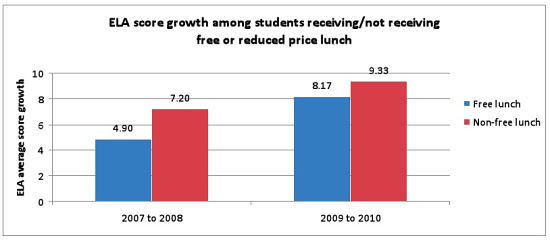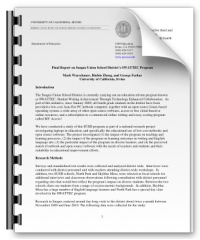The Saugus Union School District is currently carrying out an education reform program known as SWATTEC: Student Writing Achievement Through Technology Enhanced Collaboration.
As part of this initiative, since January 2009, all fourth grade students in the district have been provided a low-cost Asus Eee PC netbook computer, together with an open source Linux-based operating system, a wide array of other open source software, access to free cloud-based or online resources, and a subscription to a commercial online writing and essay scoring program called MY Access!
We have conducted a study of this SUSD program as part of a national research project investigating laptops in education, and specifically the educational use of low-cost netbooks and open source software.
The project investigated:
- the impact of the program on teaching and learning processes,
- the impact of the program on learning outcomes in writing and English language arts,
- the particular impact of the program on diverse learners, and
- the perceived match of netbook and open source software with the needs of teachers and students and their suitability in educational improvement efforts.
Learning Outcomes
Our analysis of test scores indicates that (1) there were statistically significant improvements in student performance in writing and English language arts following implementation of the laptop program, with students increasing test scores from third to fourth grade more after the program was implemented than before; (2) at-risk students increase their test score performance more than non at-risk students, thus helping close achievement gaps, and (3) test score gains were greatest for students who used the laptops the most.

Conclusion
Our observations and interviews, survey results, and analysis of test score data all point to the same conclusion: the SWATTEC program has had a positive effect on teaching and learning of writing and English language arts in SUSD. Furthermore, while all demographic groups benefited from the program, the greatest benefit accrued to those students most at risk.
These are impressive achievements, given the program is still in its early stages of implementation. We have not conducted a cost-benefit analysis to see how these results might compare to other benefits that could be received at a similar cost. However, since the district uses a low-cost netbook and, for the most part, free open source software, the overall cost is low and the ratio of benefits to cost appears high.
Results to date suggest that the program should be continued and, if possible, extended to additional grade levels.
From Final Report on Saugus Union School District's SWATTEC Program by Mark Warschauer, Binbin Zheng, and George Farkas, University of California, Irvine



I like this particular study because it echoes and reinforces previous studies as well that show how access to a laptop (especially in 1:1 programs can directly impact outcomes in language arts (reading and writing).
In Maine, the MLTI program initially reached middle school students and the reports also showed improvement in writing that continued over time. Today, students with laptops expect to write their papers and reports on the computer; it's the norm. They were lucky enough to fund adoption at the high school level so the middle school students who pioneered the program are now reaping the benefits of the continued 1:1 program in their state.
Some program critics will ask for correlation with standardized tests but I'll point out that most of the standardized tests don't actually measure process or pre-writing strategy especially in composition. With the use of the laptop and online assessment platforms, teachers can extend their curriculum in ways not previously possible especially in the areas of peer review and team or collaborative writing and research.
The SUSD program sounds very promising although I would like to know more about the use of online essay testing platform mentioned. And, will SUSD recommend that their reform/technology program be extended to the middle and high schools if not already? And for students at risk, is the program extended to the home and other members of the family to support their learning?
Authentic research in the field like this report also suggests that K-12 schools should include independent research of their technology use and outcomes when discussing 1:1 adoption. It makes a lot of sense for school systems to partner with schools of education whenever possible to at least provide the public with more insight and data about the impacts of technology in the classroom.
Scott Love
Palo Alto, CA (USA)
Thanks for your as always informative comments and questions, Scott. A few responses:
(1) At least in Saugus, the program did produce gains in standardized test scores in English language arts (that's the only area we looked at because the main curricular focus was writing. Students scores increased 33% faster in English language arts from 3rd to 4th grade after the program was implemented than prior to its implementation.
(2) There were mixed results and feelings about the MY Access (automated essay scoring and writing environment) program. In the end, the district decided not to pay for it any more and leave it up to individual schools to decide whether to use it. In particular, the teachers we interviewed who taught English learners did not feel the program was very helpful. Over time, interest in MY Access tended to fall, whereas interest in using blogs and social media stayed strong and grew. (I have written about automated essay scoring previously a bit more positively, but the more districts we observe it in we notice a similar pattern; districts tend to conclude that it's just not worth the relatively high per student annual cost.)
(3) In this district, the netbooks are not made available for home use yet. However, they do provide the open source software to parents so they can install that on home computers if they wish.
(4) This is an elementary school district (K-6). So they have no middle or high schools to extend to. They are, however, trying to extend from fourth grade to fifth and sixth and seeking creative funding options.